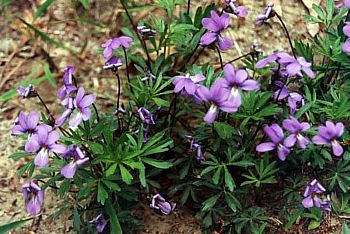Viola pedata
 |
 |
Photo courtesy Renee Brecht |
Britton & Brown Line Drawing |
| Botanical name: | Viola pedata |
| Common name: | Birdfoot violet |
| Group: | dicot |
| Family: | Violaceae |
| Growth type: | forb/herb |
| Duration: | perennial |
| Origin: | native |
| Plant height: | 4 - 10" |
| Foliage: | Basal leaves, finely dissected; similar to that of Coastal violet, but leaf divisions are not as linear or regular in Coast Violet and the middle division is often broad and irregular. |
| Flower: | Purple, often with upper petals much darker, with orange stamens. Compare to Coastal violet, which does not have orange stamens, but a white throat. 1 - 1 1/2" |
| Flowering time: | Flowers April through June. |
| Habitat: | dry, sandy fields; sunny rocky areas |
| Range in New Jersey: | Occasional through the northern counties, common in the Middle district and down the Coastal strip to Cape May; Stone notes apparently rare and introduced in the Pine Barrens. |
| Heritage ranking, if any: | n/a |
| Distribution: |  |
| Misc. | "This violet differs from the other violets known as acaulescent blue
violets by its lack of cleistogamous flowers, making it impossible for
this species to self-pollinate (McKinney, p. 17). In fact,
this is the only species of violet in North America that does not
self-pollinate (Burn, p.62)". (University
of Georgia) Stone (1911) notes that it occasionally has autumnal blooms as well. Viola, violet colored, and pedata, refers to bird-foot like leaves. One of our prettiest violets. |